
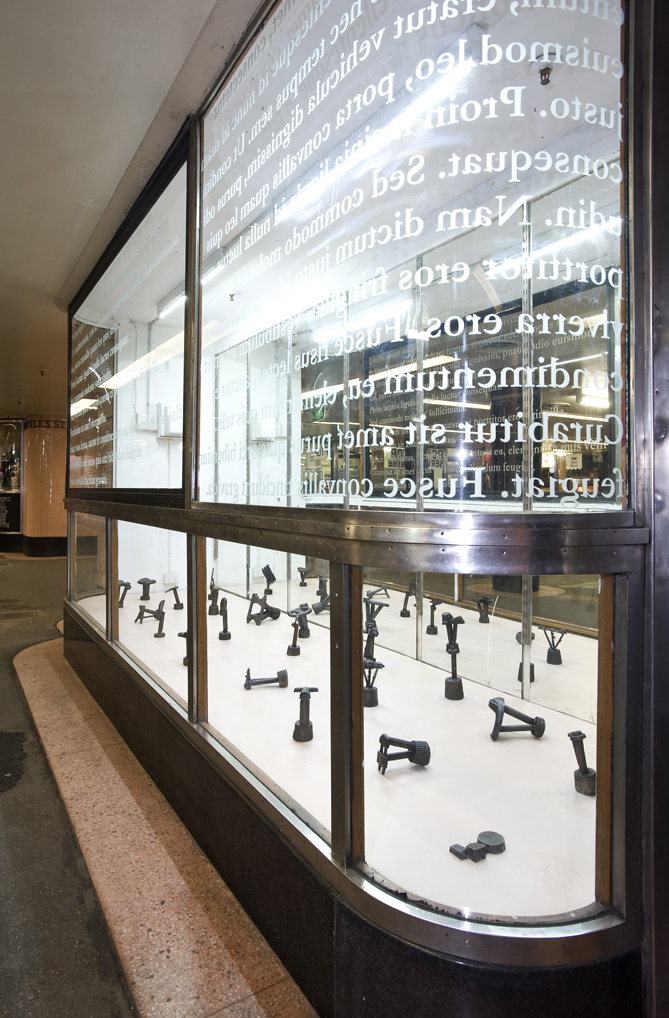
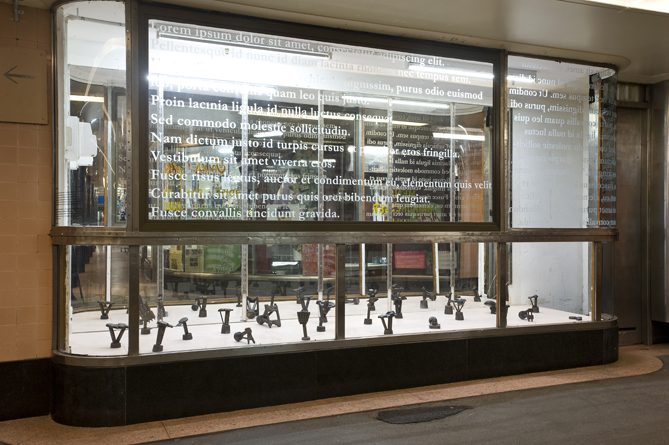
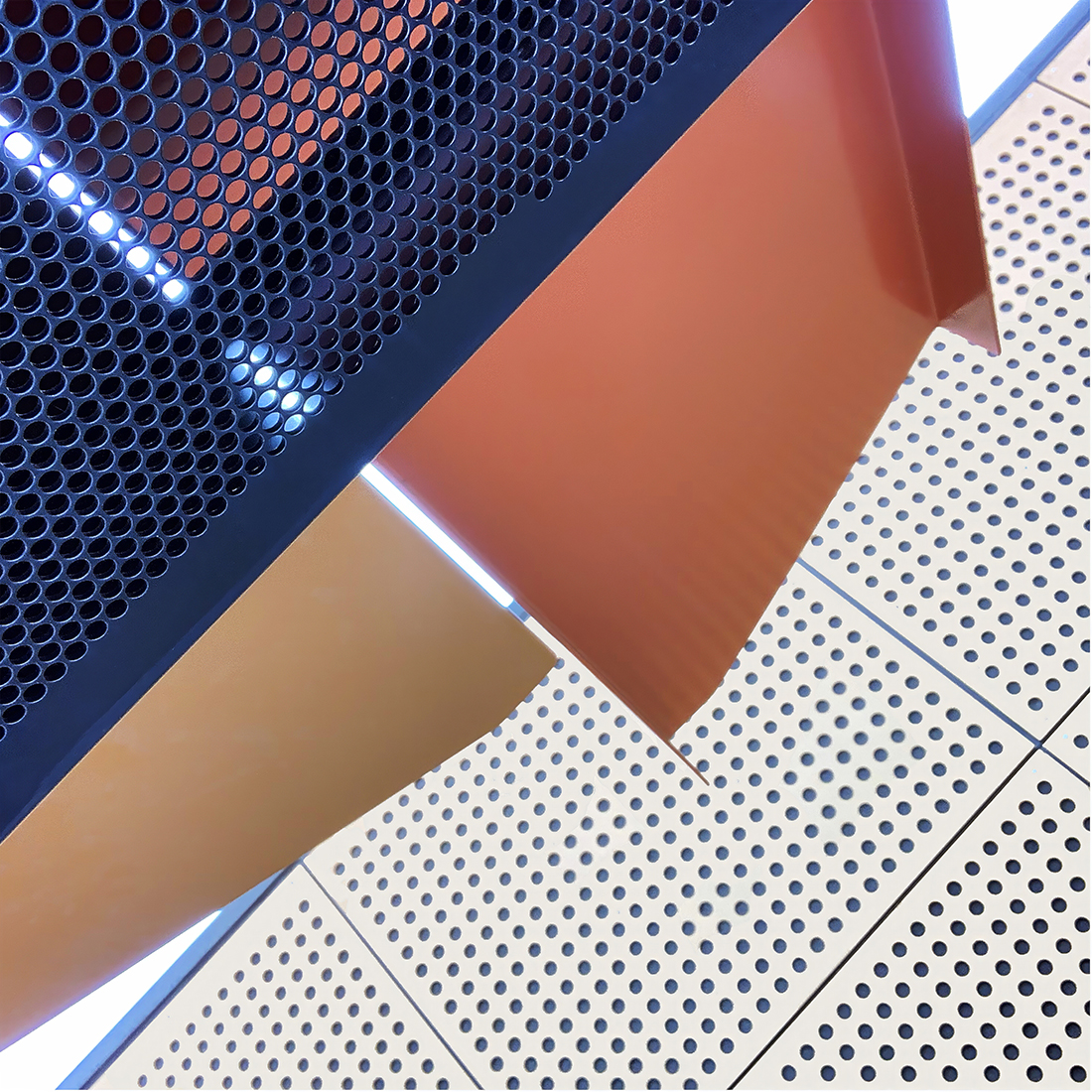
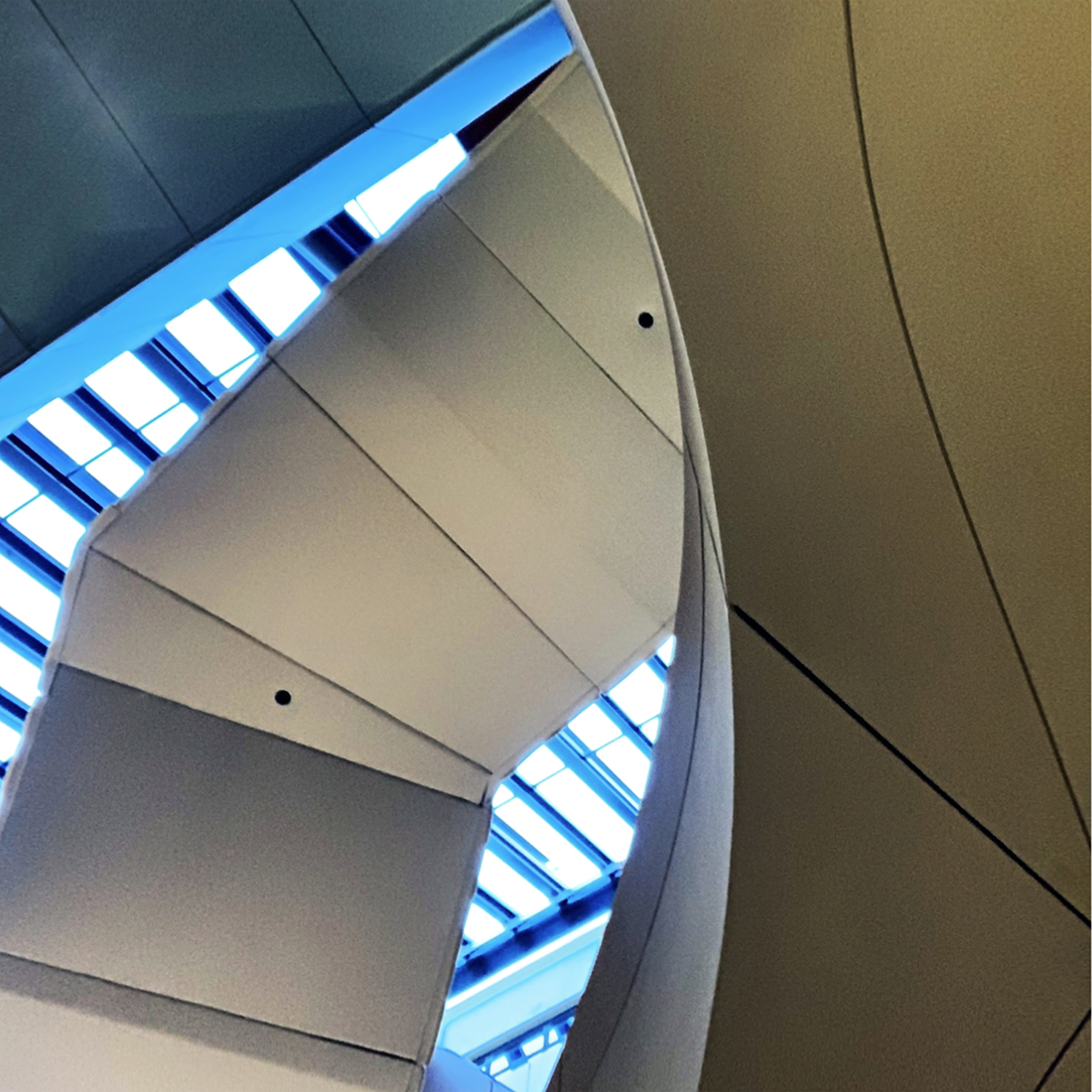
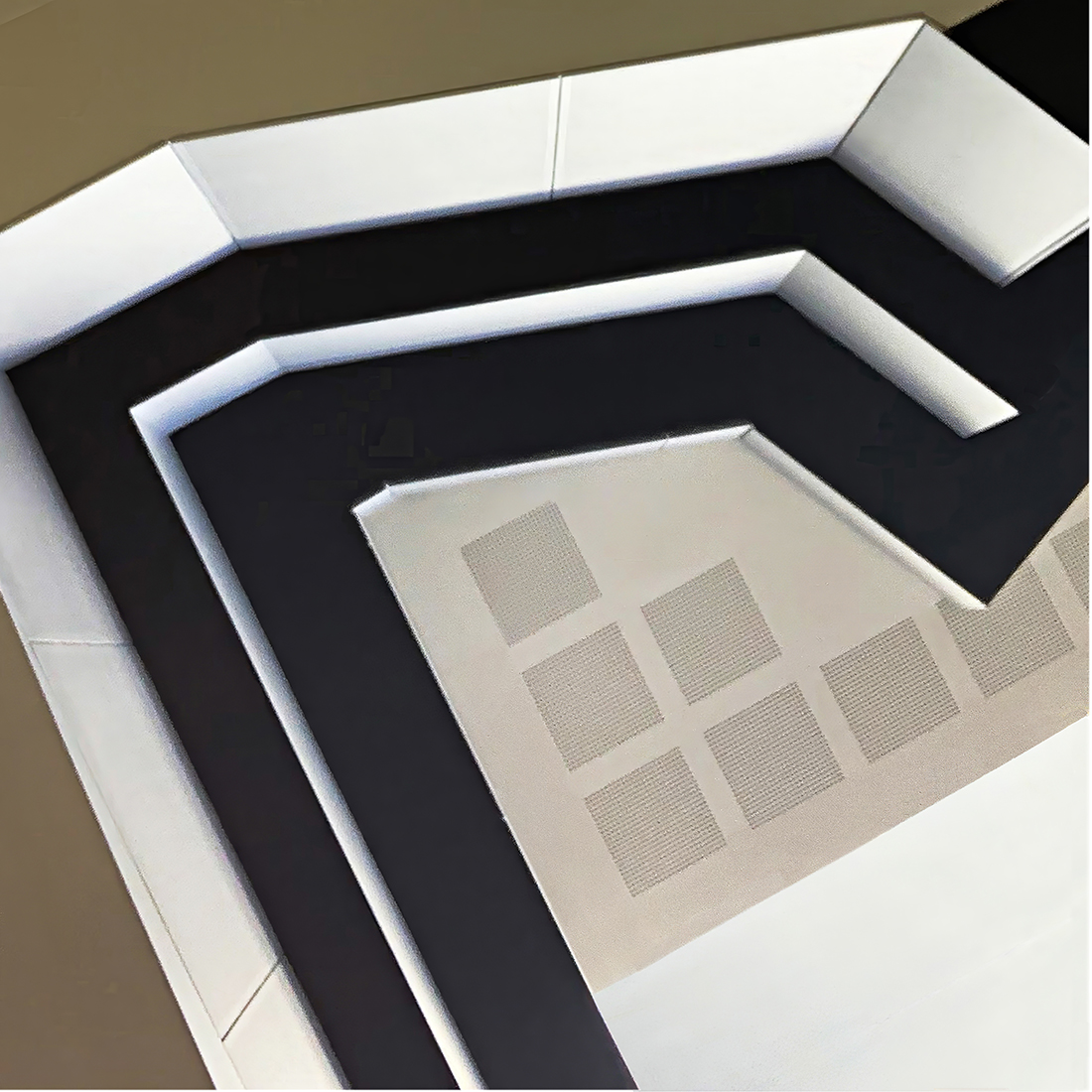

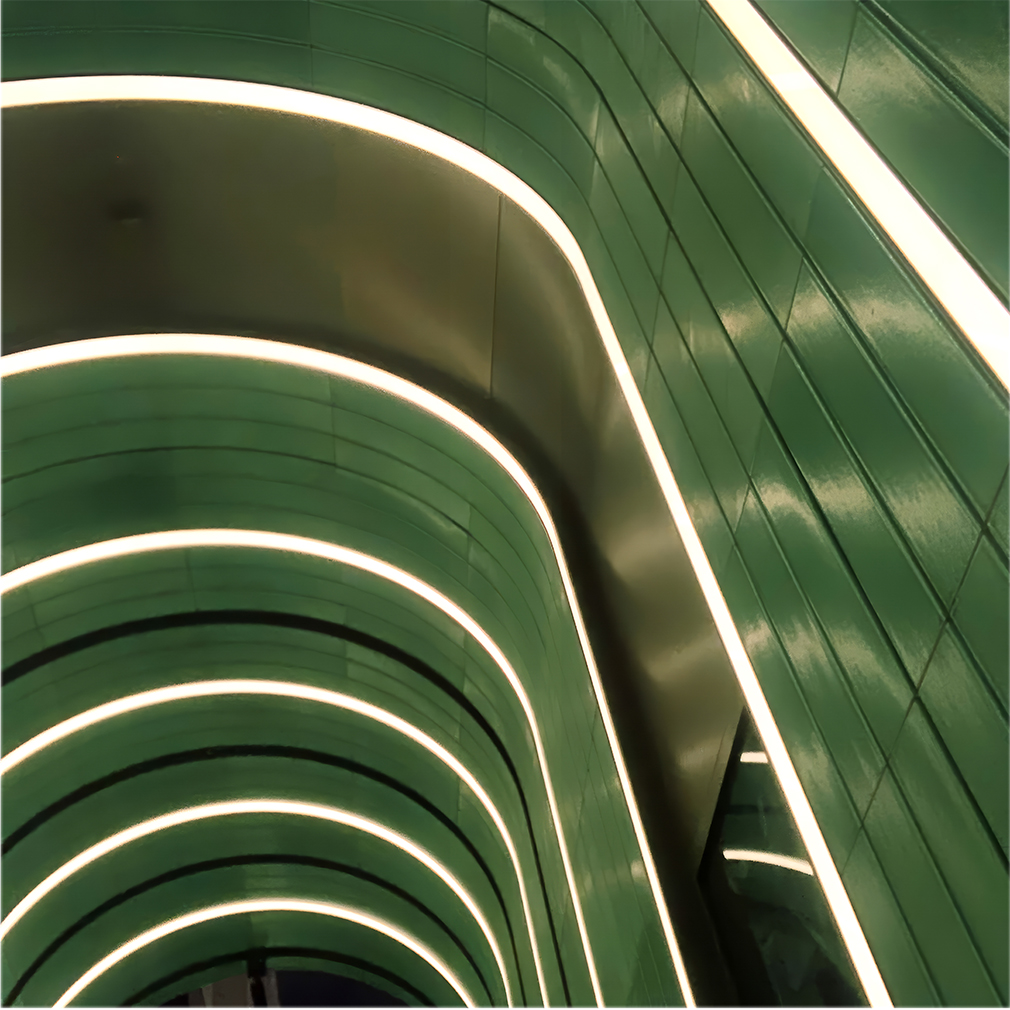
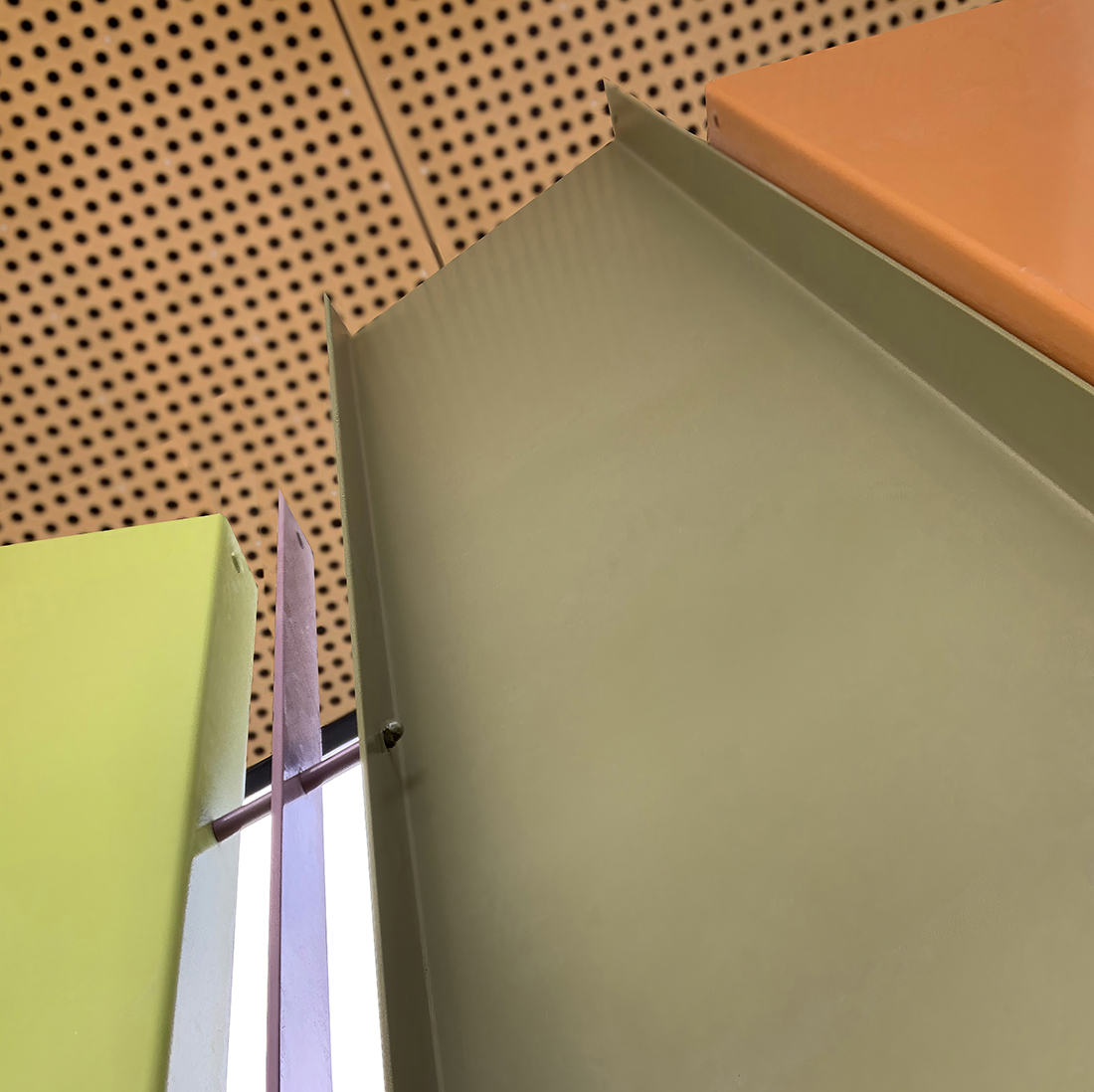
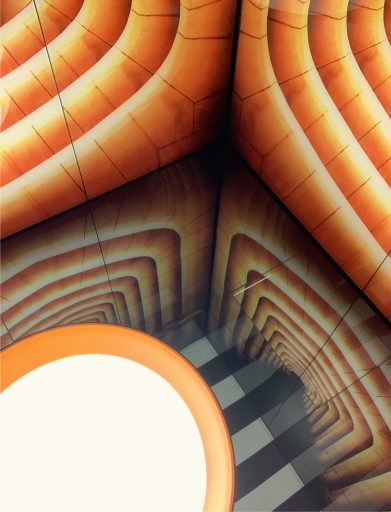
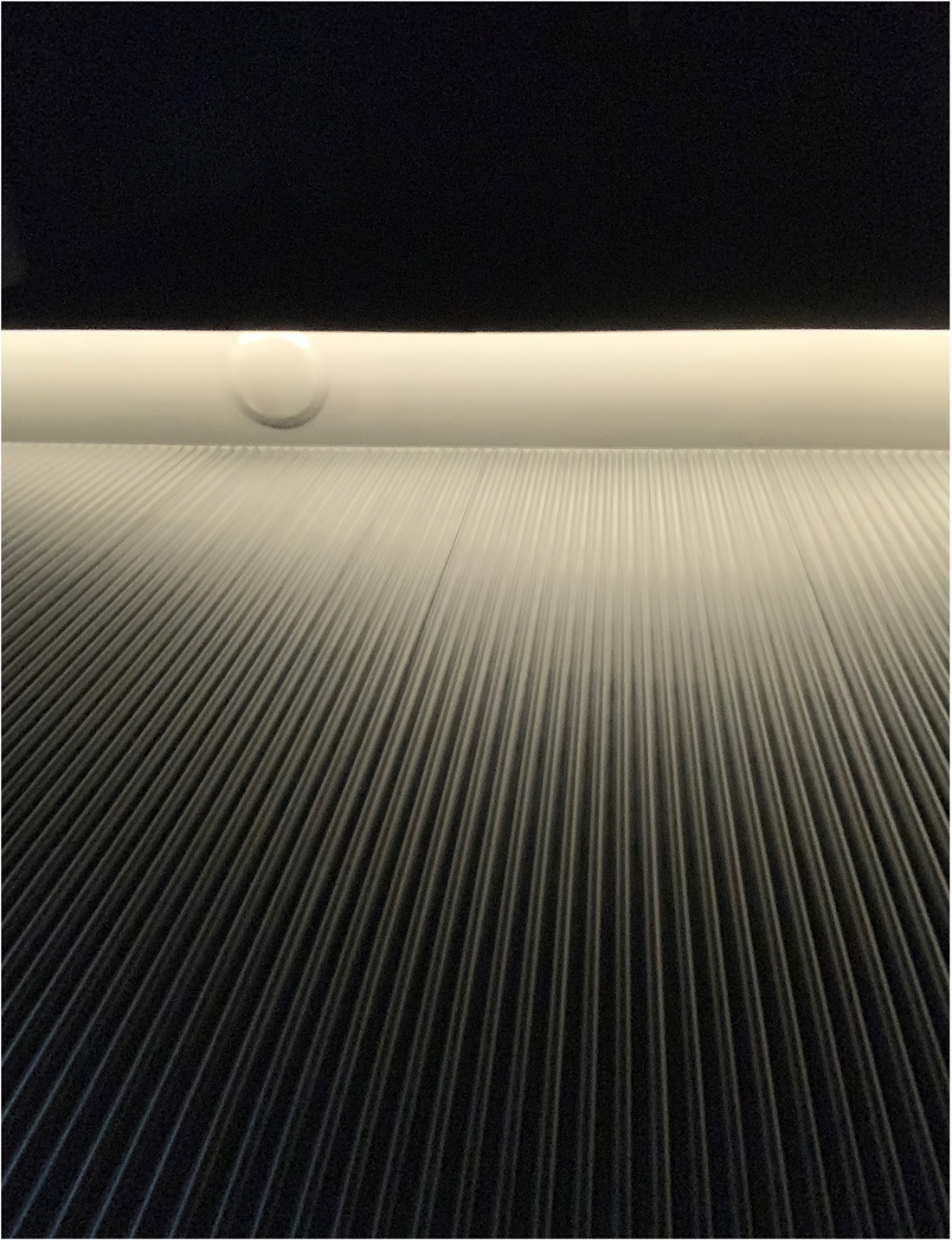
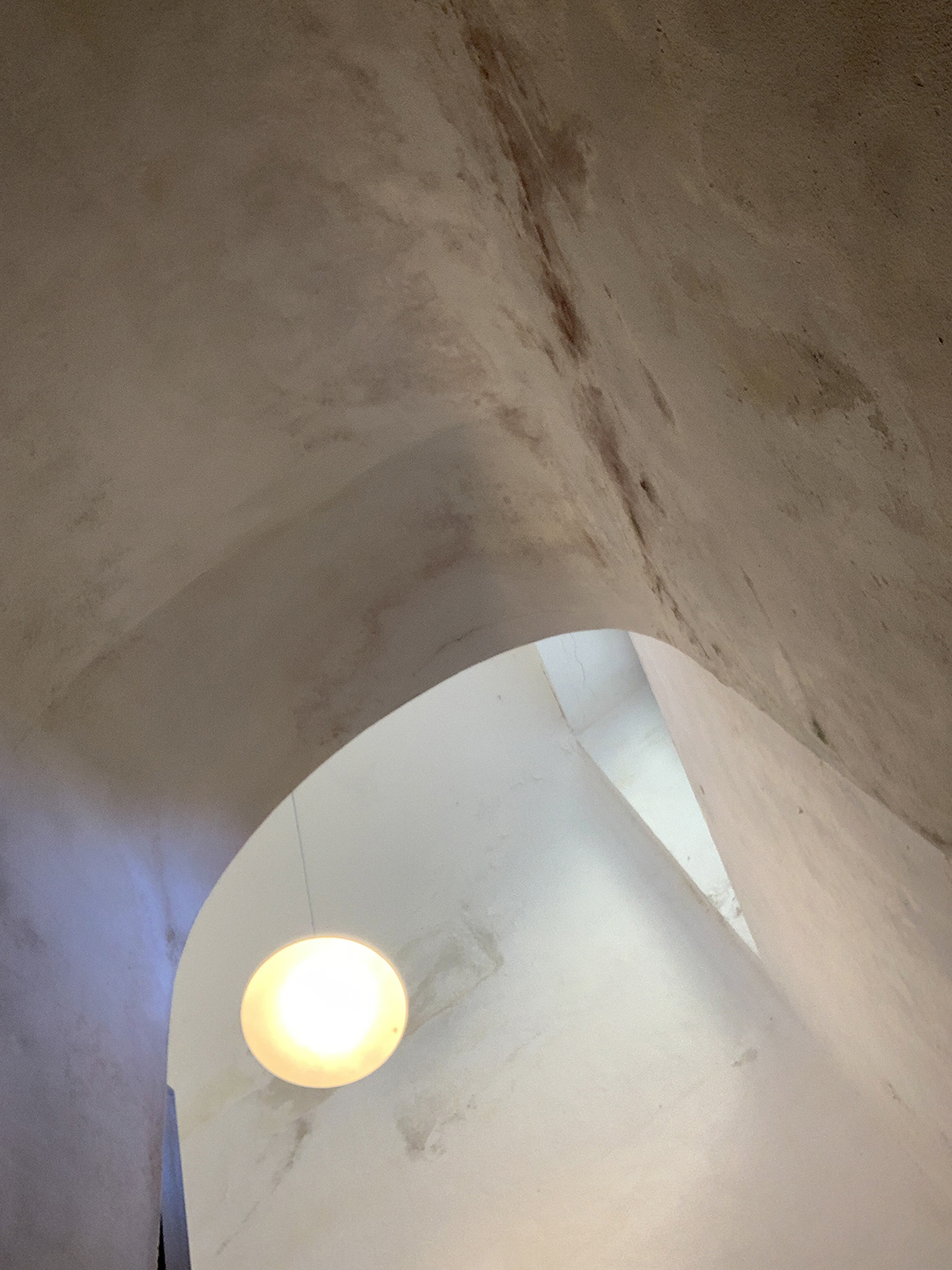
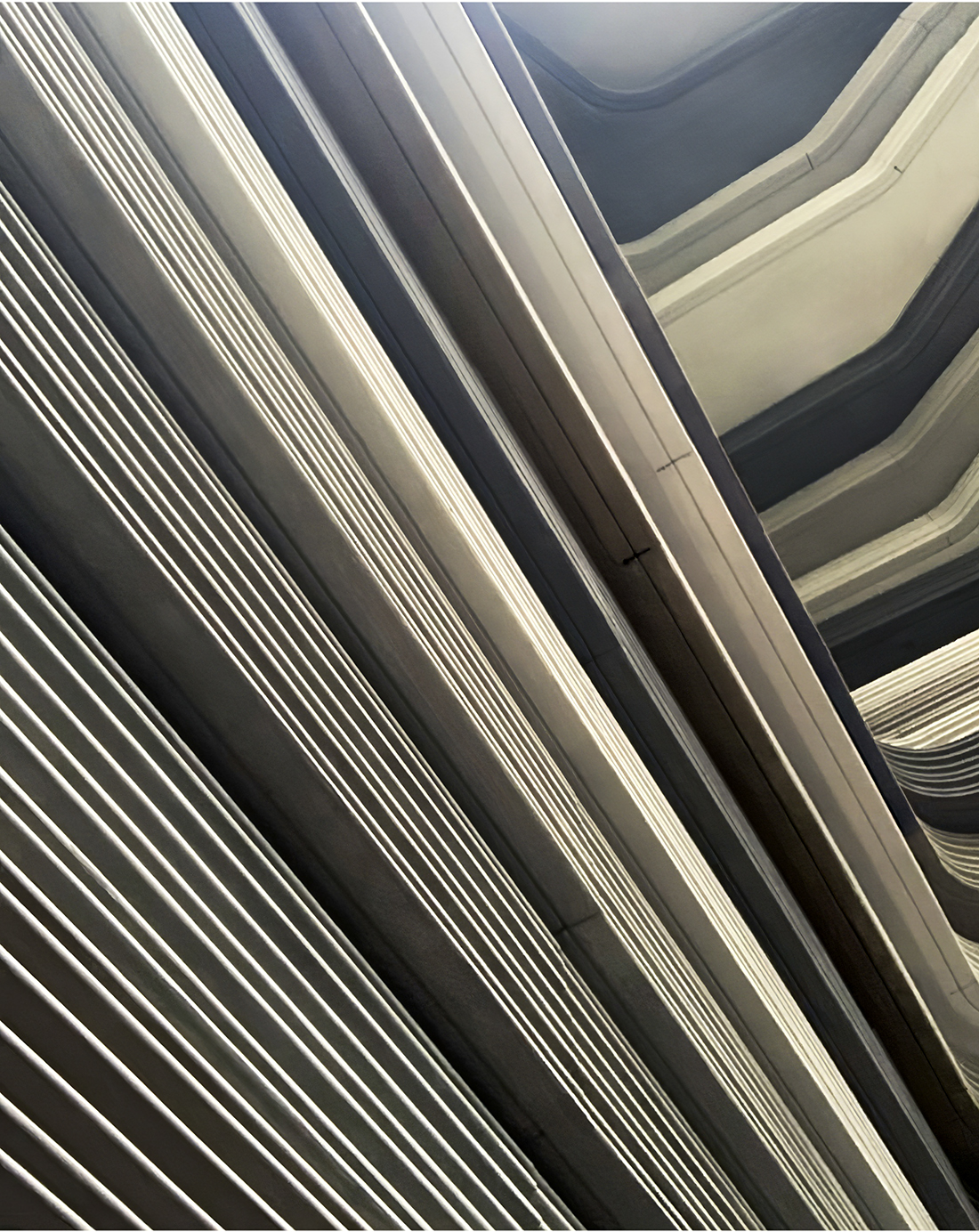
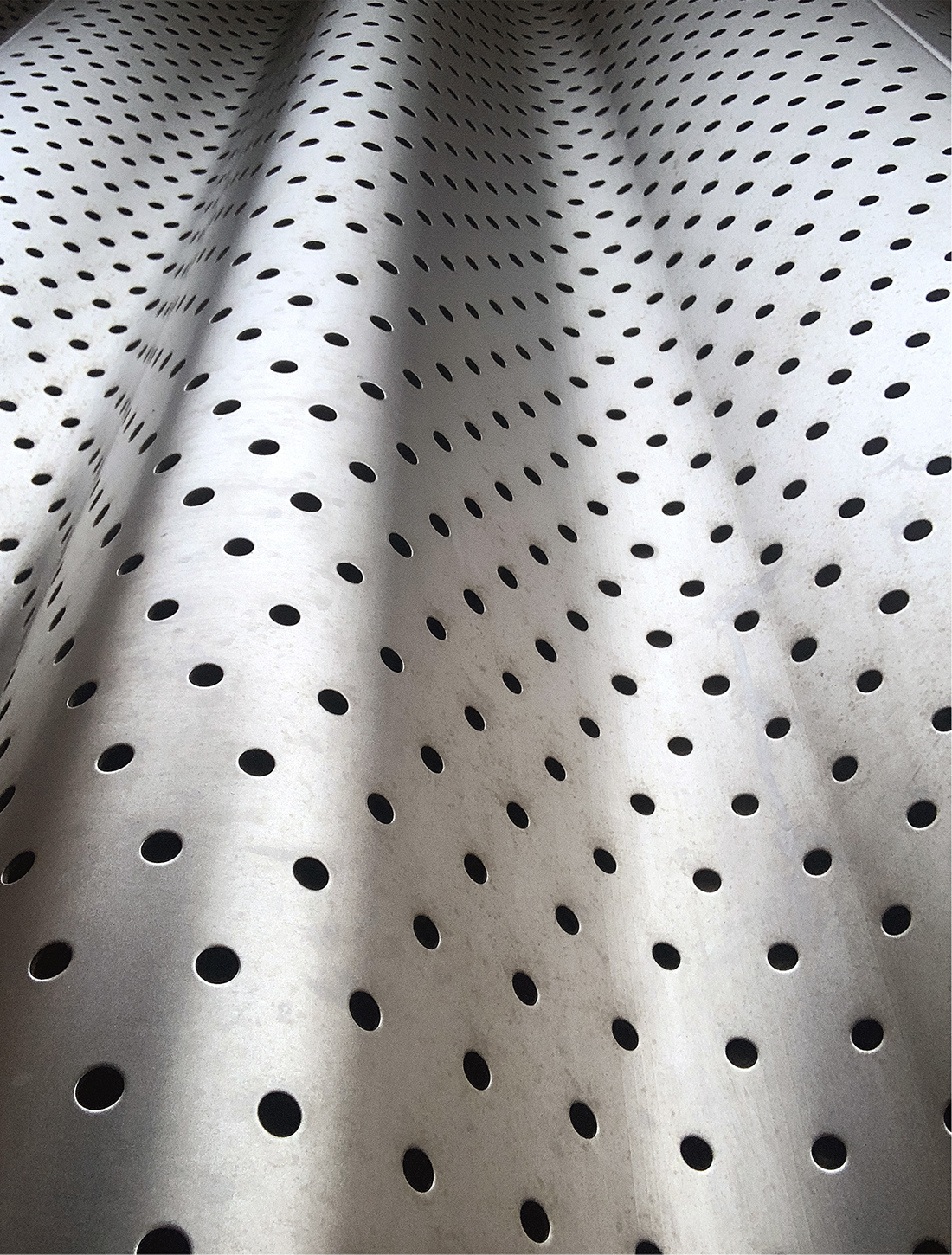
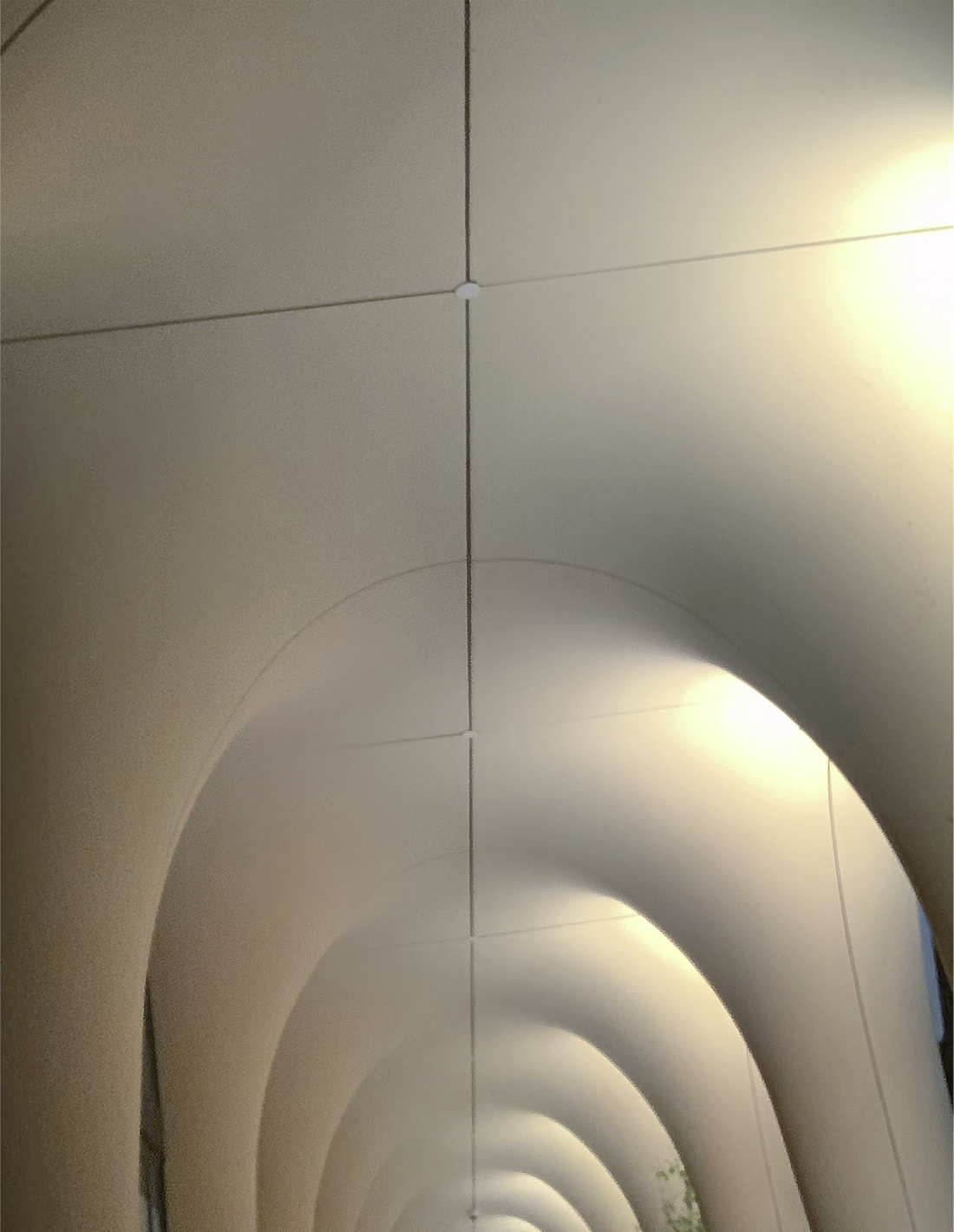
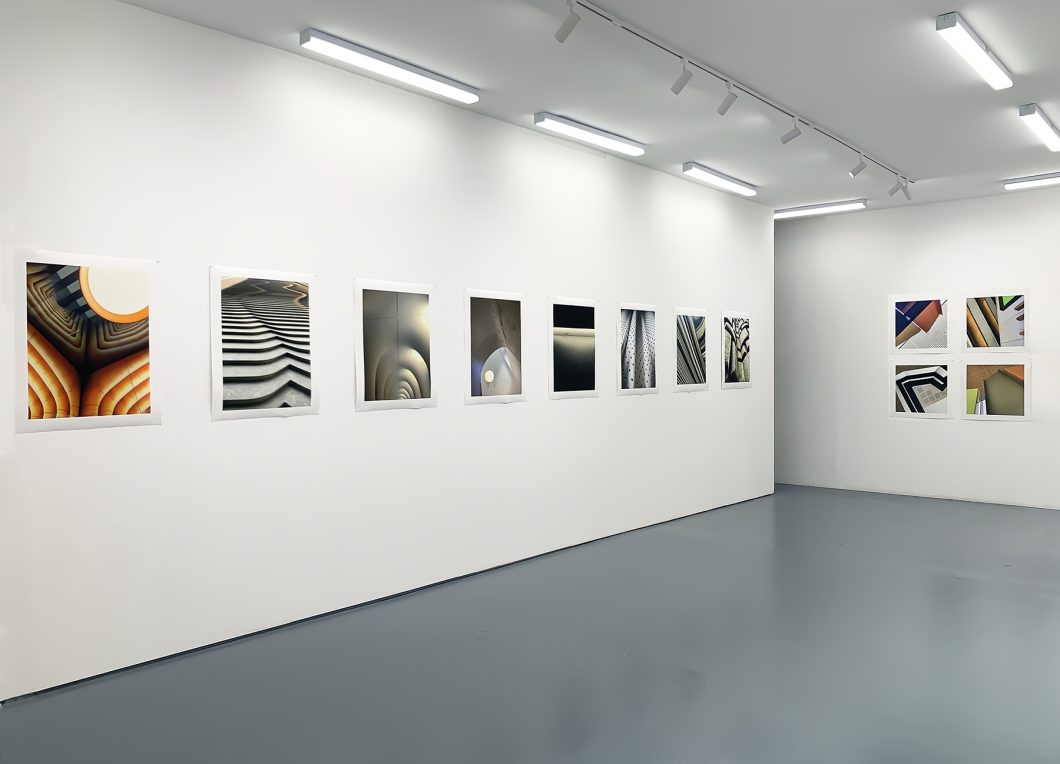
Making Strange is a snapshot of images captured when the selfie function on a mobile phone is turned away from the self and is directed at the world around us.
The familiar becomes strange, when this popular and often narcissistic mode of photography is upended, and draws attention to the overlooked qualities of things and places and relationship between them.
Bypassing two photographic brags, the high-tech, architectural hero shot devoid of people, and the low fi selfie that puts humans and places at the centre, this exhibition defamiliarises the built environment.
Ignoring big technologies, drone shots and conventions such as scale, dimensionality, perspective and context, these images of interior and exterior spaces, and the details of surfaces aim to slow things down.
Making Strange invites an engagement with these structures and their material qualities as they are perceived by the selfie-lens, and not as they are known.
Five Walls Project Space, April 2024
Drawing on 15 –17 Century religious painting of flood, fire and desert these photomontages reflect new climate realities. European old masters imagined and interpreted landscapes they had never seen and within centuries we have made them a reality. The four enigmatic children from Bellini’s Sacred Allegory (c 1490 to 1500) populate the series, further unsettling these visions of the future. Displayed in lightboxes these small illuminated series prompt a contemplation of the past, present and future.
EXHIBITED: Edge of Elsewhere, Photo 2024, Melbourne International Festival of Photography (2024).at Glen Eira Gallery, Melbourne. Curated by Diana Soumilas and the Contemporary Collective .
On Message: Environmental Prints and Posters 1978—2023, at Wagga Regional Gallery, New South Wales, 2023. Curated by Lee-Anne Hall.
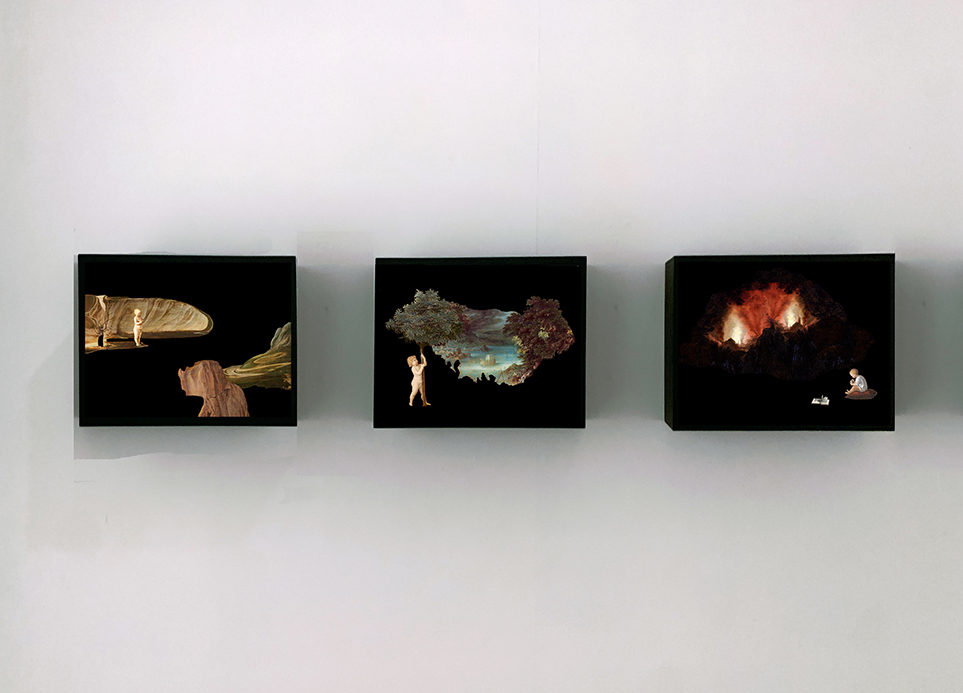
Grandmasters#sh*tf*ckery |Published by M.33| Melbourne 2021
Material Fix repairs, rather than replicates or restores, the broken bench seating around the concrete picnic tables made by the workers from the now defunct Hume pipe company. Instead crystal clear round resin forms have been installed on the concrete stands.
Making use of the visual and conceptual impact of contrasting materials, the translucent discs appear to suck in and reflect the surrounding park. Material Fix draws attention to the park’s industrial past and serves as a spectral reminder of the workers who made and enjoyed regular picnics after work.
Last Days captured the hidden life of objects and the places they inhabit in the final days of Brooklyn Art Hotel. Part home, part hotel for many who have visited Melbourne since 2006, this series of photos asked the question — if an object could take a selfie what would it look like? Shot on a mobile phone these images are a last farewell and bring into view the overlooked relationships between spaces and things before Brooklyn is emptied and handed over to a new owner.
Last Days was part of an art event Supernaculum: to the last drop, curated by Aphrodite Feros-Fooke and Tom Shepherd-Barron, March 2020.
Exhibition, pasteup: 31 Ferrars Place, South Melbourne.
The Grandmaster series reanimates the historical, allegorical and mythical themes of Old Masters paintings by combining them with choice comments made by our political leaders.
Shiels started her ‘Covid sanity project’ in 2020 and during lockdown posted her digital collages on social media. More recently selected works have had public outings as pasteups on hoardings in inner city Melbourne.
Hung like a salon in a state art gallery, the latest called ‘Six Months in Politics is a Long Time’ is a collection of prints made from January to July this year. Addressing themes such as climate change, women’s issues, Covid, refugee issues, these political parodies aim to make the politics of the day memorable.
In a time of extreme volatility and flux, it can be a slog to keep up with politics, as we get lost in the fog of reporting, analysis, and opinion. No one can be blamed for tuning out. These digital collages capture the values and decisions of our political leaders on critical issues like climate change, Covid, sexual violence against women and gender equality. The Grandmasters has been conceived to visually present these key events in a new context. The actions or inactions of this government will shape how we live in the future and like the grand narratives of history, we will look back and judge them.
More than 100 bronze objects are cast from the empty space in plastic packaging that once contained everyday consumer goods. Arranged like hieroglyphs or code this ‘future archaeology’ invites us to think about what we leave behind.
Funded by The Level Crossing Rail Authority – Victoria
Hidden Life, A Domestic Study turns the selfie function on a mobile phone away from the self in order to see what it can reveal about the world of objects and the spaces they inhabit. The familiar becomes strange when this popular and generally narcissistic mode of photography is subverted. Shot from below, the photographs defamiliarize the ordinary and draw attention to the overlooked relationship between things and the places they inhabit.
The images in this exhibition centre on the domestic environment and were mainly shot in the artists’ home. They form part of a larger Hidden Life series, which also draws on house museums and commercial spaces. This body of work — like all of Julie Shiels’ photographic and sculptural projects — encourages us to look more carefully at the world around us — especially the things that are hidden in plain sight.
Linden New Art -October 3, 2019 – November 3, 2019
This project is an invitation to send a message to the future. It can be a letter, postcard, a fiction, a photo, an artwork, poem, or song which will be collected on this site
Addressed to our future selves, children’s children, strangers or to the non-human world of wildlife, weather and waves, these reflections and responses are a prompt to re-examine how we are experiencing life on Earth and what we are leaving behind.
Conceived in a period of extraordinary flux — these personal responses will hopefully encourage us consider how we might make the world a better place.
To contribute — go to the website Letters to the Future or contact julie(at)julieshiels(dot)com(dot)au.
Exhibition and photo book
Empty is a collection of photographs taken from Shiels’ home on the 20th floor in Melbourne’s CBD. The works capture the stillness and other worldliness of these workplaces when the humans have left the room. The absence of human presence amplifies activities occurring behind the glass facades, turning the focus onto the furniture, tools, technology and personal paraphernalia that populate these spaces. Inviting a reflection on the unseen spaces in a city, Empty seeks to remind us that things continue to exist even when they slip from view.
Atrium Gallery: Sofitel Hotel, Melbourne. December 2018 – February 2019
The photo book Empty, was published by M.33, Melbourne. Essay by Julie Ewington.
All That Remains – Benalla Art Gallery March 8 – April 22, 2019
All That Remains focuses on the artist’s street-based work (2005-2109) in which she stencils dumped mattresses, couches and chairs with meaningful texts to create temporary public art from hard rubbish. Fabric from abandoned mattresses have been painstakingly remove and tenderly fashioned into soft sculpture in form of pyjamas and swatch books. Gleaned from nature strips, the artist transforms these pre-loved remnants of domestic histories into metaphors for the transience of urban lives and spaces. In this exploration of art from the street it represents us with a portrait of culture as seen our well worn everyday detritus. Bryony Nainby – Director, Benalla Art Gallery
This limited edition book is a collection of thirty-two photographs, taken by Julie Shiels with her phone, while she has been waiting. Waiting for son, husband, friends, a seat, to fall asleep, to see the doctor, for the traffic to move.
As Miles Allison says in his essay HOMELESS in UTOPIA is “the leftover bits of time that function simply to join ‘superior’ activities together.” In other words, forget Henri Cartier Bresson, this is the quintessentially “indecisive moment”. These are pictures of the moment in which absolutely nothing is happening. Terry Lane
Waiting, rediscovering boredom in the age of the smartphone. The Conversation
White Night, 2014
Geelong after Dark, 2018
All of these chairs were salvaged from hard rubbish collections and provided seating for two festivals. The invitation ‘Please take your seat’ was stencilled in many languages on the individual chairs. Visitors were invited to sit on the chairs and watch the projections and at the end of the evening to –‘please take your seat’ home.
In collaboration with Nina Sanadze
Oil pastels on Melbourne bollards, 2017.
Employing quotes from renowned writers and thinkers, the project reflects on how the security bollards that populated Melbourne during 2017 operated as both a protective device but also a threat to freedom.
Early this year I packed up my studio and moved. In the process excavated 13 years of ideas, materials and found objects. This exhibition realises some of these ambitions and consists of artworks I that never started, things I started but never finished, and artworks that that were remade from something else.
‘the unmade, the remade and the half baked’ is another way of considering what goes on in an artist studio, how ideas hang about and about how materials and matter transform from one manifestation to another.
All are works that relate to my interest in the overlooked within everyday settings but also how things (including ideas for art work) continue to exist even when they slip from view.
Rachel’s Pile, 2017, acrylic and wax, various dimensions
Installation view
Understory # 1-4, 2017, found wallpaper mural with excised sections, various dimensions
Recasting the space under a single bed, 2017, found bed legs, timber and plastic, 135 x 185 x 16cms
Recasting the space under a single bed, 2017, detail
Heidegegger’s Crutch, 2017, found timber crutches and epoxy, 120 x 50cm
Sunday Best 8, 2010, recycled mattress fabric, 35 x 125cm
Pick up your towel, 2017, bronze, 51 x 36 x 8cm
The Last Move, Albert Tower, South Melbourne, 2013, aluminium
The Last Move is part of an extended body of work by Melbourne artist Julie Shiels which derives from the shapes of vacuum-formed plastic ‘blister packs.’ It therefore arises initially out of the modernist tradition of the ‘readymade’ or the ‘found object’, where ordinary, quotidian objects are selected or modified or combined in such ways as to grant them the status of works of art.
However, The Last Move is not simply a piece of consumer culture detritus randomly chosen for elevation into the realm of art. The packaging shape on which it is based has been quite deliberately chosen for its specific, functional resonances. It in fact derives from the plastic covering of a stationery supplier’s ‘removal kit’, a handy combination of adhesive tape dispenser, slicing blade and fibre-tipped pen – all you need for packing and labelling cardboard boxes. The work’s title therefore makes direct reference to the lives of the building’s residents, and to their new apartment as final (or perhaps just most recent) destination.
There is, however, still more to the work. The strange three-pronged form is at once intriguing and elusive, like a sign in an unfamiliar alphabet. The profile has clear echoes the famous ‘duck-rabbit problem’ in the psychology of visual perception. In three dimensions, the form has a strange robotic, sci-fi character, like something from the control panel of an alien spaceship. There is even a suggestion of the outline of a key, a useful reminder for residents leaving or entering the building.
More abstractly, the work plays with perception and expectation: initially in the way it makes a void into a solid; then in its uncanny upscaling; and finally in its triple iteration – lying flat on its concrete support and standing up in both horizontal and vertical orientation. Finally, these two upright elevations present distinctly different faces to occupants of the building and to passers-by on the footpath: the silver of the contoured aluminium front and the silhouette of the flat black back.
Changing character as sun and shadow move across its component parts over the course of a day, The Last Move makes something extraordinary out of the ordinary, something marvellous out of moving house.
David Hansen, Associate Professor, The Centre for Art History and Design, ANU.
Cast aluminum, 75 x 92 x 310 cm
Small Moments on a Long Street (2015) is a collection of ordinary objects reproduced in bronze and integrated into unexpected locations in Hampton Street, Hampton. Each object has been installed so it appears to be slightly out of place – like a lost item or something left behind after an event has occurred. The themes and titles of each work are: Change of Temperature, Traces of Time, Measure of Change, Matters of Substance, and Essence of Place, and are located along a kilometre long shopping strip in Hampton.
Image 1: Measure of Change, bronze
Image 2: Change of Temperature, bronze
Image 3: Matter of Substance, bronze
Image 4: Essence of Place, bronze (studio shot)
UBIQUITOUS OBJECT, AMBIVALENT THINGS: PhD Exhibition, Margaret Lawrence Gallery, 2015
The ambivalent things in this exhibition emerge from ubiquitous objects: clear plastic packages or blister packs. Rather than working with trash as constituent materials, this project focuses on the space left behind by the act of consumption, abstracting and reproducing the void in discarded packaging.
Ubiquitous Object, Ambivalent Things reflects on the how remnants of consumption might be apprehended beyond the status of the commodity and endeavours to navigate around ‘aesthetic fatigue’ — a visual overload of images relating to waste (Scanlan 2013). The project uses the ‘ready made’ mould of the plastic package to visualise the space of consumption, inviting poetic reflections on the temporality, materiality and mutability of waste.
PhD Extended Abstract: Ubiquitous Object, Invisible Things:
Material Affect, Objects 1 – 9 (2013) photogram — silver gelatin print, 93 X 111 cm.
Shrink (2015) vacuum formed acrylic and vinyl lettering (Lorem Ipsum), various dimensions.
Things Fall Apart (2013 – 15) peg board and dry plaster, 232 x 360 cm.
Breach (2015) plaster and MDF, 240 x 250 cm.
Hook (2015) resin, various dimensions.
Gap (2012) acrylic dye and thread, 400 x 250 cm.
Resisting Disappearance, Texts 1 – 4 (2015) digital print, various dimensions.
Resisting Disappearance is derived from the empty space found in clear plastic packaging. The transparent form of the empty vacuum package is both an object in itself and an echo of the commodity it once encased.
The voids in these ready-made moulds have been amplified and transposed using two ephemeral materials: light and dried plaster. Julie Shiels uses a combination of photograms and loose caste objects to visualize a trash item in a way that can be perceived beyond its status as commodity. The project seeks to reflect on the temporality, the materiality and the mutability of waste.
Loose plaster, MDF, digital prints. Dimensions variable.
Quoting: Screens is collection of texts that were gleaned from active and abandoned blogs and then inscribed on dumped obsolete TVs. The street and cyberspace are both public spaces where things get discarded and forgotten. (2011 — 2013)
For nearly a decade, Shiels has transformed hundreds of abandoned objects on local streets with stencils of quotations and truisms Making use of discarded things and found text, these ephemeral works reveal the tensions of gentrification, impermanence and the passing of time. (2005 — 14)
This series of text work manifests in three different forms: text stencilled onto discarded furniture and cardboard boxes (Boxes), and vinyl lettering on obsolete TVs (Screens).
These temporary interventions refer to stencil art and graffiti but without imposing an indelible mark on public or private property.
The work also mimics the conventions of advertising by using computer generated text and inserted into public places. The fonts suggest corporate branding and it only at a second glance that the content emerges. These interventions hopefully disrupt to the viewer’s acceptance of commercial interests as ‘ordinary’ in the natural order of the urban landscape.
The project started in 2005 and was originally posted on ilovestkilda.com. In 2008 the project migrated to writinginpublicspaces until 2014.
A collection of photographs that record Julie Shiels ephemeral text interventions on urban waste has been published by M.33. As Long as it Lasts
Twenty-five kilograms of dry plaster powder is given form when it is packed into the empty space in a clear plastic package that once held a consumer item.
Things Fall Apart combines two machine-made spaces that are used to order and protect everyday objects. The first is the empty space in a clear plastic package that once contained a consumer item. The second type of space is the hole in a handyman’s peg-board. These spaces are reassigned in a way that extends both their original purpose and their materiality.
The package is used as a mould to distribute serial forms across an expansive platform made from a handyman’s pegboard. The mould and the material are the same in each case, yet no one form is identical to another.
During this exhibition the same sack of plaster will be transformed three times. Each week the powdery castes will be swept up and reformed into a new set of relationships and patterns. However despite these efforts by the artist to influence the relationship between objects, the crumbling forms will assert their own agency and affect each other ‘even when humans are not watching’.[1]
Combining the regular pattern of holes with repetitions of the powder casts This is an experiment with certainty and instability, order and unpredictability, of control and letting go and challenges our anthropocentric version of the world.
[1] Graham Harman “Autonomous objects” New Formations No. 71, pp. 125-130 (2011)
Catalogue Essay
Things e-catalogue (PDF) →
An exhibition over two venues curated by Elizabeth Gower, investigating the appropriation of urban detritus and ephemera as a contemporary art strategy.
Artists include Lauren Berkowitz, Ryan Foote, Michael Georgetti, Nathan Gray, Matt Hinkley, Lou Hubbard, Christopher LG Hill, Melanie Irwin, Ash Keating, Nicholas Mangan, Rowan McNaught, John Nixon, Louise Paramor, Simon Pericich, Joshua Petherick, Caroline Phillips, Elvis Richardson, Stuart Ringholt, Ilia Rosli, Julie Shiels, Slow Art Collective, Kate Smith, Charlie Sofo, Masato Takasaka and Alex Vivian.
Julie Shiels, Work, Play and Sustenance, 2013, acrylic, plaster and silicon at Margaret Lawrence Gallery
Installation view: Julie Shiels As Long as it Lasts, video 2013 and Micheal Geogetti, Love in the Machine World, at The Substation
Postings consists of a set of phrases such as “endless cycle”, “full circle” and “vicious circle”. The individual letters are cut out of magnetic sheets and assembled on metal lampposts and fire hydrants.
The viewer can very easily rework the text, to make new words or transform the letters into decorative patterns – or rude suggestions!
Photography: Christian Capurro and Julie Shiels
When a person undergoes a surgical procedure the operation is booked, the risks are assessed and the date anticipated. On the day, the body is prepped and dressed in a special gown but as consciousness slips away, the actual event becomes a void.
Cusp, materialises this void by casting the space in empty packaging that once held surgical implements and devices used in the operating theatre and asks: can these memories be reclaimed? Can we insert our own narratives of illness, healing and intervention into these empty spaces or would we prefer to forget. What and where is this space we inhabit?
Project Space: RMIT, 2010
This series of text work manifests in three different forms: text stencilled onto discarded furniture, cardboard boxes, and a series of words made from magnetic material and wrapped around metal lamp posts.
Cardboard boxes are the canvas for these temporary work. Ubiquitous container for the things we buy, disposed of with little thought to be recycled into yet another round of packaging. They are also a useful material for the resourceful gleaner; providing temporary shelter for a night on the streets, or useful to make a sign document, documenting a hard-luck story, requesting a few coins for a meal or a coffee or a bed: signs that nobody ever reads properly. (2007)
In a globalised world, cities are rapidly becoming homogeneous spaces. At first glance difference is disappearing, we see the same cars, same buildings, same franchises and hear the same noises.
This work expands the exploration of the ideas in a project called I love St Kilda. That is, that the marks on the pavement and the minutiae found in the streets can tell you where you are and provide clues for deciphering the narratives of the cultural terrain.
The site also documents a series of ephemeral works that are surprise interventions in the streets.
I love St Kilda was an interactive website diary that started in 2005 and gathered simple observations, images and comments about forgotten or largely overlooked moments in everyday St Kilda.
As a catalogue or archive of these moments and memories this work sat as an uncomfortable counterpoint to the cacophony of voices that were arguing about gentrification at the time.
The site also documented a series of ephemeral works that are surprise interventions in the streets.
In 2007 ilovestkilda migrated to citytraces.net and expanded its enquiry of the urban beyond the boundaries of St Kilda.
A monument to a local indigenous elder but also a gathering place for the living.
The idea for this work came from a conversation with Aunty Alma in 2002 when we were both sitting on plastic milk crates in St Kilda’s O’Donnell Gardens. I remarked what good seats they were but she said she often had to hunt around to find one. I suggested that we could turn them into bronze and put them in permanently.
After that, every time I saw Aunty Alma she would say, ‘You got to do that, babe. Put it in bronze.’ I was already hunting for money when she died in April 2003, so I felt even more compelled to make at least one seat for her. She was a queen of the park.
When another well-known Elder, ‘Boom Boom’ Forbes died the next year, everyone said Aunty Alma would get lonely just being honoured with one crate so found enough money to make three crates. The third is for the living.
Silkscreen posters made from 1984 – 88 at Another Planet Posters
Cooking Stories was an exhibition with food, recipes & storytelling at its core.
The vital ingredient in this exhibition was a story about a meal with an associated event. By concentrating on food we captured the story from a totally different angle, accessible to people of any background. This way of telling stories is a powerful way of describing something of life, culture, identity and the importance of food.The result is a collection of stories that reflect the refugee journey in all its diversity.
Immigration Museum, Melbourne, 2003-4
Margins Memories and Markers (2003 – 2005) permanently imbeds people’s personal memories about place into the urban landscape. Consisting of 6 permanent artworks and over 60 texts works, the project was conceived to mark the end of a long period of gentrification.
Julie Shiels: Creative Director, community consultation, artist and writer
Images
Tommy’s Story: Bill Perrin
Maria’s Story: Julie Shiels
Port Boy: Dianna Wells and Helen Bodycombe
They Wandered: Simon Perry
27 Stories: Maggie Fooke and Julie Shiels
Listening Place: Ros Bandt and Julie Shiels